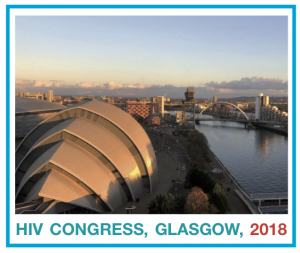Vertical transmission remains very low in UK and Ireland: update from the National Study of HIV in Pregnancy and Childhood
12 December 2018. Related: Conference reports, Pregnancy, HIV 14 Glasgow 2018.
 Polly Clayden, HIV i-Base
Polly Clayden, HIV i-Base
The vertical transmission rate among diagnosed women living with HIV in the UK/Ireland remains very low at 0.28%, according to recent findings from the National Study of HIV in Pregnancy and Childhood (NSHPC).
The NSHPC has been running since 1989 and conducts comprehensive surveillance of all pregnancies to diagnosed women with HIV in the UK/Ireland. To date there have been over 20,000 pregnancies reported to the NSHPC, approximately 1200 per year. In 2012–2014, the vertical HIV transmission rate was 0.27% among diagnosed women living with HIV.
Helen Peters presented NSHPC data describing maternal characteristics and vertical transmission among singleton liveborn infants in 2015–2016 (with infection status reported by 31 March 2018) at HIV Glasgow 2018. The presentation included reports of planned and/or supported breastfeeding since 2012.
There were 1914 singleton livebirths: 71% to black African women and 83% to women born outside UK/Ireland. Over 99% of pregnancies were among women receiving ART; 70% conceiving on ART.
Among 1230 infants with data on maternal viral load within 30 days of delivery, 93% of mothers were undetectable <50 copies/mL. The proportion of women achieving undetectable viral load at delivery has increased from 87% in 2012–2014.
Infection status was confirmed for 1438 (75%) of infants at the time of analysis. There were four transmissions: two infants whose mothers were diagnosed after 20 weeks’ gestation after late presentation and one born to a woman diagnosed before conception with detectable delivery viral load (these three transmissions were utero); and one infant with postnatal transmission likely through breastfeeding (PCR negative at 6 weeks, positive at 18 months).
The overall vertical transmission rate for 2015–2016 was 0.28% (95% CI 0.08% to 0.71%). For women diagnosed before pregnancy with undetectable viral load throughout pregnancy the rate was 1/526; 0.17% (95% CI 0.01 to 0.92).
There were 70 reports of planned and/or supported breastfeeding among women on fully suppressive ART since 2012 (duration ranged from one day to two years/ongoing). Of these, 36 infants were born during 2015–2016. Infection status has not been confirmed in some cases and monitoring is ongoing.
The investigators noted for the likely postnatal transmission described above, the mother did not inform clinicians she was breastfeeding, so did not have appropriate clinical support.
The British HIV Association (BHIVA) currently recommends formula feeding but states that virologically suppressed women living with HIV on ART with good adherence who choose/plan to breastfeed may be clinically supported to do so. BHIVA recommends monthly HIV testing for mother and child.
comment
The investigators suggest that the reports of breastfeeding reflect guideline updates, the current U=U era and continued steps towards normalisation of maternity experiences for women living with HIV.
But these require careful monitoring which is enabled by the NSHPC parallel paediatric surveillance scheme of children diagnosed with HIV up to 16 years and HIV exposed infants. This ensures identification of any late postnatal transmissions and appropriate adjustment of the vertical transmission rate.
The NSHPC has recently enhanced data collection among breast feeding cases – this is the first time this has been followed comprehensively in the UK/Ireland. The NSHPC investigators hope this data will provide valuable insights and will inform future guidelines.
Reference
Peters H et al. Successes and emerging challenges in prevention of vertical HIV transmission in the UK and Ireland. HIV Glasgow.
28–31 October 2018. Glasgow, UK. Poster abstract P003.
https://vimeo.com/298177308 (Webcast)

